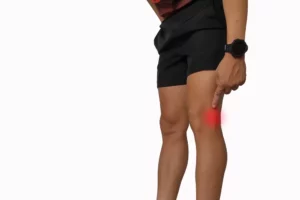Pain in the IT band is one of the most common forms of knee pain. However, its frequent occurrence doesn’t make it any less painful or impactful for those who find themselves with the condition. One of the goals of a physical therapist in Pueblo is to not simply treat the pain but to treat the underlying cause. Thankfully, there are several things that you can do to strengthen your body, minimize pain, and reduce recurrence. Before jumping ahead into a solution, however, it is a good idea to know more about the condition itself.
What is IT Band Syndrome?

IT Band Syndrome is named after the Iliotibial Band, a connective tissue that starts at the top of the hip and runs down the thigh to the knee. Repetitive motion such as running, biking, or hiking, can lead to pain and inflammation in the areas around the IT band, such as the bone and the bursa.
There are many situations that can lead to IT Band Syndrome. Some Pueblo athletes find that they experience pain after training for too long or too strenuously. Also, not spending the right amount of time in warming up the muscles and ligaments around the knee through stretching and light exercise before training can lead to this symptom. Finally, poor footwear such as old or ill-fitting shoes can lead to injury and pain in the IT band.
Some individuals may have a higher chance of developing IT Band Syndrom if they spend a lot of time running on uneven surfaces, downhill, or on tilted surfaces. Runners should always be aware that some tracks and roads are slightly tilted, and running only one way can cause an imbalance of the hips, leading to IT band problems. Running on flat surfaces or changing your direction can help to balance out your hips.
Other individuals may be at risk of developing this syndrome if they have a history of knee problems, or if they have bowed legs, legs that have slightly different lengths, or muscle weakness. Walking with legs or feet rotated inward can also cause this syndrome. Bicyclists should pay attention to the tilt of their feet and knees when riding since inward pedaling can also cause this condition.
What Are the Symptoms of IT Band Syndrome?
There is some confusion about where the pain occurs with IT Band syndrome. Because the connective tissue stretches all the way from the hip to the knee, some people, and even some medical professionals, think that pain in the hip or thigh can be categorized as IT Band Syndrome. In fact, this syndrome refers to pain in the knee only, although some people may experience pain that radiates from the knee to the hip.
Common symptoms may include soreness, stabbing pain, or a stinging type pain on the outer side of the knee, noticeable swelling in this area, and pain in the knee while walking, running, or biking. Some individuals report a popping sensation when bending and straightening the leg.
Diagnosing IT Band Syndrome
When diagnosing IT Band Syndrome, your medical professional will take a detailed history of activity and symptoms. The syndrome can usually be diagnosed through observation and talking with the patient, but some doctors will occasionally order MRIs to rule out other conditions.
Treating IT Band Syndrome
Mild cases of IT Band Syndrome may simply benefit from standard at-home care such as resting and putting ice on the area. Many of these cases will improve and heal over time without medical intervention. Pueblo patients with more severe, complicated, or chronic cases should seek help from a physical therapist before considering surgery as most cases can be resolved without having to resort to these measures.
Physical Therapy: More Than a Bandaid for Pain
The goal of physical therapy is to strengthen and heal the body in order to treat the underlying cause of the pain. Anti-inflammatory medication, while useful in the short term, is not an adequate solution for long-term care of IT Band Syndrome. There are many methods used by physical therapists that can help to alleviate the pain and improve your quality of life by making many of these temporary fixes unnecessary.
Physical therapists will look at different things to help determine the cause of the pain. They will analyze the gait, leg length, and the strength of the muscles around the area to help the patient make relevant changes to their lifestyle. This can include anything from changing their posture to investing in shoes that will help balance out the hips. The physical therapist will then use a personalized combination of treatments such as ultrasound therapy, strengthening exercises, targeted massage, and stretches.
Exercises to Help with IT Band Pain
In addition to the RICE technique (rest, ice, compression, and elevation), there are several home treatments that you can use to strengthen the area around the IT band and to minimize some of the pain from a mild case of IT Band Syndrome. Exercises targeted at the hip and knee areas can help with the condition. It is always important to remember to stop doing an exercise if it causes pain and to consult your doctor or physical therapist before trying something new, but here are a few exercises you can try at home.
Clamshell: While lying down on your side, place your knees and feet together. Keep the feet together, and gently lift your top knee up and down. You can repeat this exercise up to 15 times, and do 2 sets.
Hip Bridge with Resistance Band: If you have a resistance band at home you can trying using it in a hip bridge exercise. While lying flat on your back on the floor, place a resistance band over the knees. With knees slightly apart, slowly lift the hips until your back and thighs form a straight line between your knees and shoulders. Lower and repeat 3 sets of 10.
Hip Flexor Stretches: When hip flexors are tight it can cause unevenness and pain in the IT band. To stretch the hip flexor, while in a standing position, place one knee on a chair. Use your buttocks muscles to tilt the hips forward until you can feel a stretch, and then hold for 30 seconds. Repeat the exercise 2 times. You can also do this stretch while lying down on your back and pulling the knee towards your chest until you feel a stretch in the hip. Hold this stretch for 30 seconds and repeat twice.
IT Band Syndrome is common, but that doesn’t mean it can’t affect you negatively. If normal self-care methods are not working to alleviate your pain, talk to a physical therapist about possible treatment plans. You don’t have to live with your IT band pain.
At Synergy Physical Therapy & Wellness & Wellness, we are passionate about helping people of all ages regain their pain-free lives without the use of medications, injections, and surgery. We see many patients who have been frustrated with their previous recovery process, and we love to watch them begin to experience relief from their chronic back, neck, shoulder, and knee pain.
